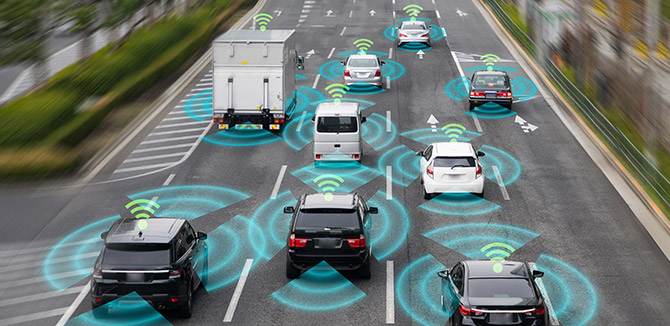Where Will the Transportation Industry Be In 20 Years?

From policy enforcement to workman’s compensation issues, the avenues for detecting activity in and around a vehicle are beginning to expand. In the next 20 years, that expansion will enter a new realm, said Lytx VP of Technology Michael Phillippi, Lytx’s tech guru. In honor of Lytx’s 20th anniversary year, we asked him where the transportation industry—and specifically, telematics—is headed over the next 20 years. Here’s Phillippi’s take on it all.
Where we stand today
In 2018, the transportation industry is still in the early phases of telematics adoption. About 15 to 20 percent of vehicles have telematics installed, and just 5 percent have a video telematics program.
“There’s a tremendous opportunity for organic growth in the telematics realm,” Phillippi said. “In the next 20 years, you can expect video telematics saturation to jump to 80 or 90 percent.”
That leap may sound huge now, but it’s a reasonable estimate given that many telematics providers have partnered with camera makers to bring their own video telematics programs to market. “There’s no telematics provider that doesn’t have some sort of video telematics offering,” Phillippi said. “So that trend is well positioned for substantial growth in the future.”
What’s coming in the next 20 years
Over the next two decades, telematics technology will become more refined, helping commercial fleets reach new heights, Phillippi said. Telematics providers already have created products that integrate video with telematics to show not just speed or how hard a driver brakes or accelerates, but also when a driver started to push down on the brake or the gas pedal.
Such revelations have wide-ranging impacts for fleet safety managers or investigators, who must decipher a driver’s level of awareness as events unfolded.
“For example, if you’re looking at an event captured on a video event recorder, it’s important to know whether the driver braked, how hard he or she accelerated, and when exactly the driver started to decelerate,” Phillippi said. “When did a pedestrian become observable, and when did the driver take action?
Such details tell the whole story of what occurred and help video observers gauge the driver’s level of awareness or distraction. And in the next 20 years, video telematics will become more refined to show so many more scenarios, beyond safety alone. We’re at the beginning of that expansion right now.”
Sensor technology gaining steam in the transportation industry
In 2018, we can apply radar information to video to show things like location or following distance, but in the next 20 years, sensing technology will advance to include sensors for all sorts of functions: refrigeration, lifting a waste bin, opening a door, and elevating a cherry picker.
The sensing technology of tomorrow will empower fleets to solve their industry-specific needs more efficiently and directly, no matter which one they’re in, Phillippi said.
“By adding video intelligence to sensors, you’ll be able to identify and address operational risks as well as driver-related risks,” Phillippi said. “For example, you’ll be able to confirm that cargo was in good condition when it was picked up, that it stayed protected while in route, and that it was delivered to its final destination in good condition. Sensors combined with video could help guarantee the location, condition, and temperature of the cargo.”
Also on the horizon: geofencing of cargo, to help fleets and drivers ensure that cargo is within the vehicle or at its pickup or drop-off point when it should be. “Sensors are driving operational efficiencies, and in the next 20 years they’ll push the boundaries of what fleets in the transportation industry can achieve,” Phillippi said.
Even now, municipalities across the U.S. are exploring how to use sensors to turn roads into “smart roads.” Phillippi envisions a world where stop signs or lane reflectors could actually be smart sensors that help make a city’s infrastructure more connected, informed and automated.
“If the infrastructure is smarter, it means cities will be able to route traffic in safer, more dynamic ways, depending on the state of traffic patterns and congestion. There may be a purpose as to how lanes are divided, based on accidents or the pace of rush hour. It’s pretty efficient stuff.”
For Lytx clients, it means they’ll be able to label video to track more behaviors and help drivers maneuver better through construction zones, fog, snowstorms, or rain. Fleets will be able to track more driver behaviors than they can today, and in real time, Phillippi said. "Imagine one day someone calls your company and says your truck is weaving into another lane. You could take a look at the video, see if the driver is nodding off, and pull the driver off the road immediately if you have to.”
And it could all happen in seconds, because information processing will be much faster, Phillippi said. “In addition, video telematics will be driven by artificial intelligence that will enable transportation managers to have more productive conversations with their drivers.
We’ll be able to understand more risky behaviors that show a larger pattern. You’ll have more data in real time, more scenarios that can be detected through video telematics, and more solutions for commercial fleets.”
In 2018, commercial fleets are on the cutting edge of a major technological shift. “It will be exciting to see all the telematics-centered advancements that emerge in the next two decades,” Phillippi said. “They’re really going to push the boundaries of what’s possible.”
